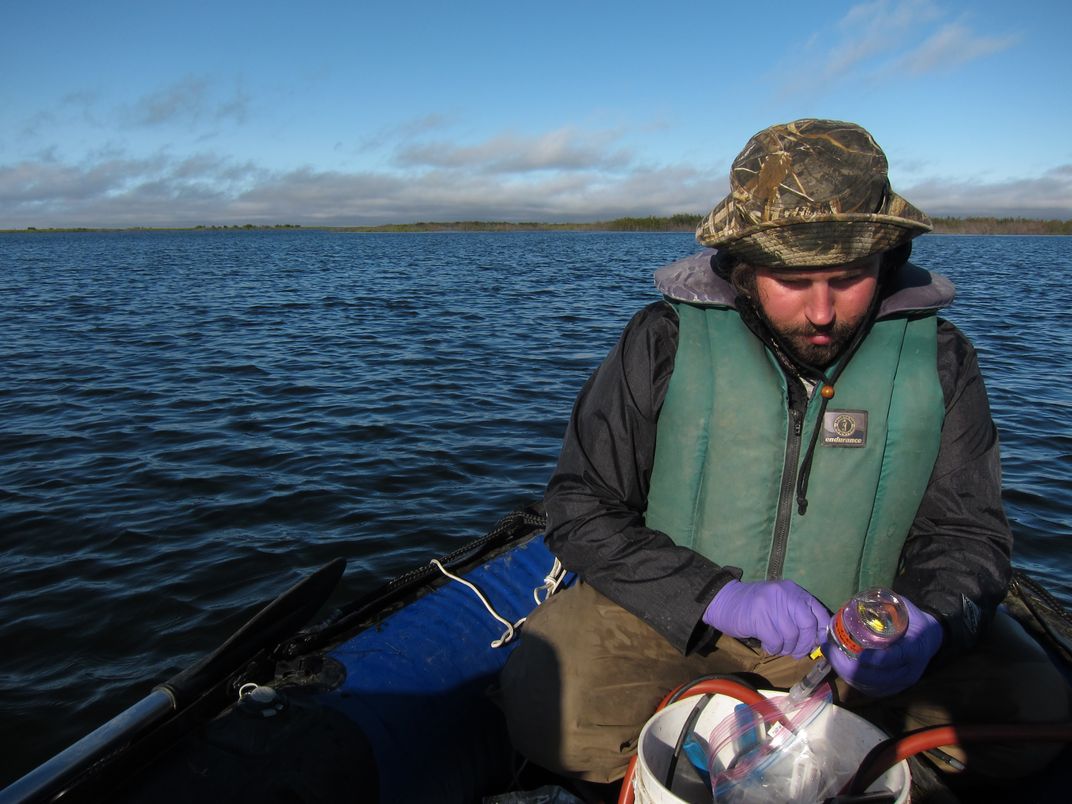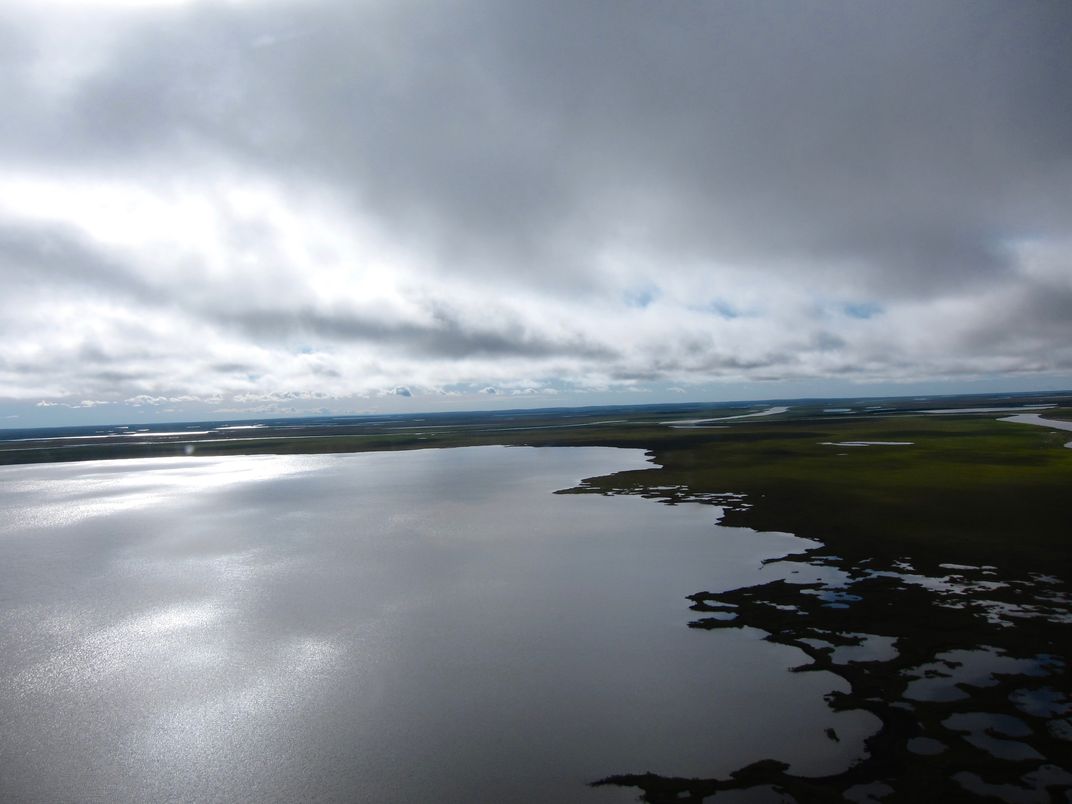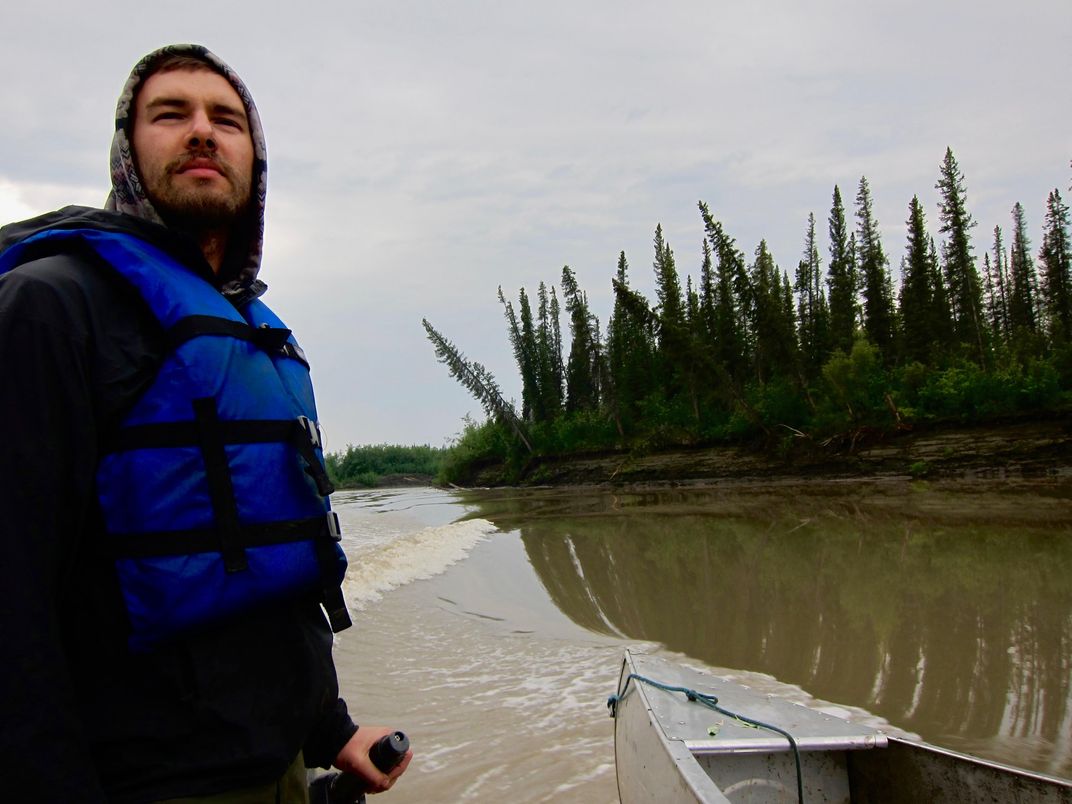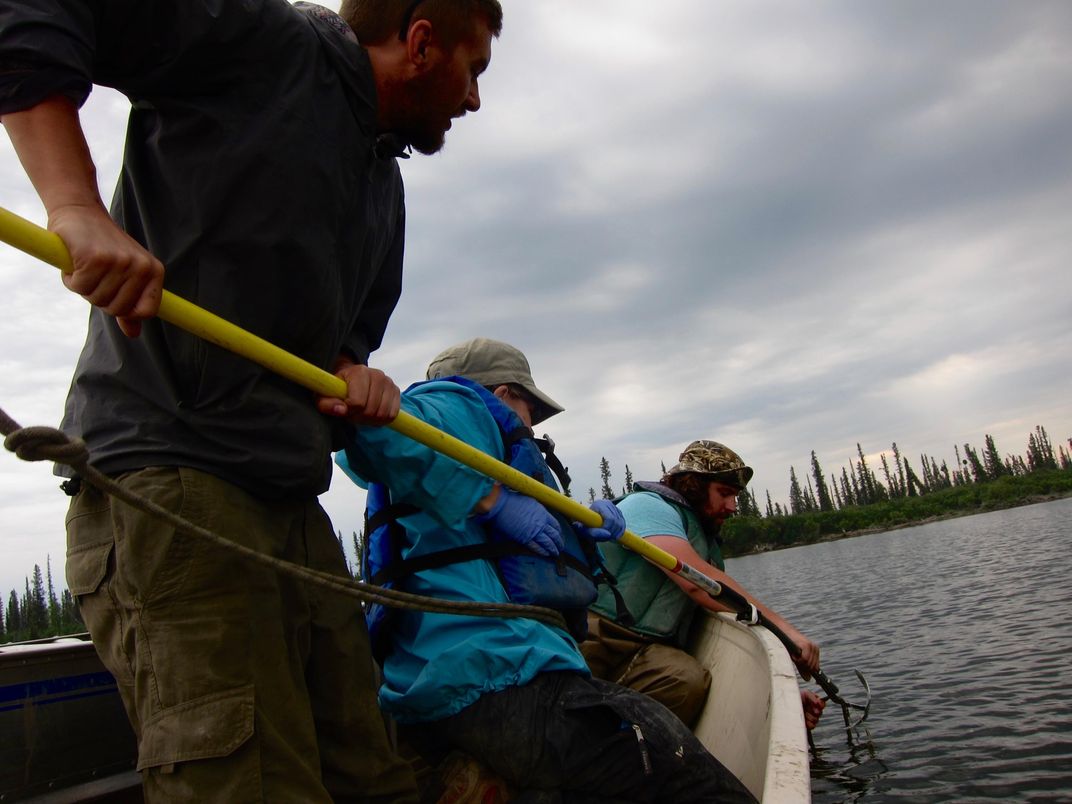With Federal Funds Dwindling, Climate Scientists Turn to Unusual Partnerships to Study Methane in a Warming Arctic
As the urgency of climate change becomes tangible to those in the Arctic, federal funds are growing harder to come by
/https://tf-cmsv2-smithsonianmag-media.s3.amazonaws.com/filer/79/2a/792a7015-5ccf-4eb3-a1ac-88a4541aba77/methane_image_1.jpg)
It’s a sunny day in August, and I’m soaring in a helicopter with two earth scientists high above Canada’s Mackenzie River Delta. As we chop several miles northward closer to the Arctic Ocean, I peer out the window, trying to catch a glimpse of the majestic muskox, grizzly bears or other animals that make their home among the sprawling Canadian forests of spiky Dr. Seussian trees.
Charismatic mammals, however, aren't what we’re here for. Geochemist Geoff Wheat and his technician Trevor Fournier from the University of Alaska Fairbanks are on the lookout for something far more subtle in the surprisingly lush landscape below: “Bubbles,” Wheat says, pointing to one of literally thousands of lakes beneath us. “That’s the lake we’re going to.”
Sure, they may not be as exciting as grizzlies. But these bubbles are full of methane, and Wheat and Fournier are here as members of a larger international collaboration trying to measure the quantity of this potent greenhouse gas fizzing out of the lakes. This is Wheat’s fourth trip to the region since 2014, where he studies trace quantities of metals in lake water and sediments that can provide information about methane buildup. For the rest of the year, the pair primarily work together on deep sea projects.
Figuring out just how much methane is leaving the lakes is crucial. Though less prevalent in the atmosphere than carbon dioxide, methane is roughly 30 times more powerful of a heat-trapping gas, and has already accounted for about one-sixth of recent climate warming according to NASA. Moreover, for every degree that Earth’s temperature rises, methane entering the atmosphere from microorganisms in lakes and wetlands is expected to increase—thus worsening the overall problem.
In the Canadian Arctic, this gas builds up in the lakes each winter beneath a thick lid of ice. Come spring, that lid melts and methane escapes into the air above. Multiply this effect over the astonishing 55,000 lakes within this massive delta—one of the largest in the Arctic—and the weight of the greenhouse gas burbling out each year could balloon to as much as 10 teragrams.
For reference, that’s the weight of more than 1 million elephants.
“That would be a very significant part of the global methane flux to the atmosphere just coming from this one delta,” says Beth Orcutt, an oceanographer at Bigelow Laboratory for Ocean Sciences in East Boothbay, Maine and one of Wheat’s collaborators.
Orcutt says “would,” because she and her team thinks that climate models may be seriously underestimating the role that methane in this delta plays in global climate warming. As a result, they see their work as having serious urgency. And yet, even as warming in this region speeds up—with roads heaving and communities scrambling to secure their buildings on thawing ground—federal funding for climate research has become harder to come by.
To buoy their project, the team is taking a uniquely collaborative approach that includes U.S. and Canadian researchers in geology, microbiology, limnology (the study of lakes) and oceanography. All of these researchers are in close connection with native communities within the Canadian Northwest Territories. “I think it is unusual for a deep sea scientist to be involved in Arctic lakes,” says Lance Lesack, a team member and limnologist at Simon Fraser University in British Columbia, referring to Orcutt and Wheat. “But partnering up makes a lot of sense to answer questions we haven't been able to answer any other way.”
Joining forces in this way leverages funds, knowledge and experience, Lesack adds. In fact, many researchers say that such creative collaborations may be the most promising way forward as climate scientists fight to continue working in one of the world’s fastest changing environments. Which is a good thing, because with federal funds dwindling, these researchers and communities may have no choice but to band together.

…
As we fly into Inuvik, a remote town of 3,000 people and the team’s home base, I’m hit by the burning smell of forest fire coming from a distance. The afternoon heat reaches nearly 80 degrees Fahrenheit, which won’t cool off much in the 24-hour-sunlight that characterizes the Arctic summer. But talk to locals, and they say that such heatwaves have become more commonplace in recent years.
Albert Elias, an elder who is Inuvialuit, or Western Canadian Inuit, grew up hunting on the land. He says the timing of hunting seasons has dramatically shifted in his lifetime, with springtime caribou hunt starting a month earlier than it used to, and the fall ice fishing starting a month later. Getting to and from hunting grounds has also become more dangerous.
“There’s lots of erosion on the shore and on the delta and all over the place. It’s really bad,” Elias says.
Scientists like Lesack are starting to reach out to non-scientist natives like Elias who live in the region year round, have already felt the impacts of warming, and have their own intimate knowledge of the land that will help tie the pieces of the warming puzzle together.
Lesack has been studying lakes in the region every year since 1989. These lakes range in size from larger than a football field to the size of half a tennis court, and curve in shapes resembling odd body organs. The strikingly pockmarked landscape is unique to the Arctic, and has created a biological hotspot for thousands of nesting migratory shorebirds, caribou, Arctic char and other animals.
Lesack has found that the timing of the breakup of ice on the Mackenzie River and surrounding lakes has also become earlier since he began studying the region. The numerous lakes form as a result of so-called ice jamming on the river that occurs each spring. In this process, ice breaks up from the warmer south to the north—the same direction the river flows—creating a dam as it accumulates downstream.
This sends a wave of ice progressively breaking up and moving toward the Arctic ocean, Lesack says. “When this happens, the water backs up in behind the ice and moves off into all these channels,” where it flows into lakes, he adds.
Orcutt and Wheat have teamed up with Lesack to study this region in recent years, bringing with them an innovative yet simple water sampling device called an OsmoSampler that they use for their unrelated deep sea studies. Capable of collecting continuous water samples over months or years without a power source, this device consists of a coil of narrow tubing about 1 millimeter in diameter connected to a so-called osmotic pump. The pump—zip-tied with the coil in a plastic milk crate—contains fresh and saltwater chambers separated by a membrane.
Invented by researcher Hans Jannasch at the Monterey Bay Aquarium Research Institute in the 1990s, the main benefits of the OsmoSampler is its simplicity and the ability to collect continuous water samples without power. Each day, freshwater trickles upward into the saltwater chamber via osmosis, passively pulling water from the environment in through the other end of the narrow tubing.
“In these remote areas, it would be totally impractical for somebody to go out once a week to do this kind of work,” says Orcutt. “So that’s the benefit of what we are trying to do.”

…
Over several days in August, I joined the team in both collecting and deploying these samplers on lakes close to Inuvik and others in the outer delta, accessible only by helicopter.
The deployment is pleasingly simple. A team member takes a GPS reading and a water depth measurement so that they can find it years from now, and we are on our way. Retrieving an OsmoSampler deployed last year is pretty straightforward, too. We follow a GPS point to where it should be, and fish around with a metal rod until hitting the familiar feeling of a milk crate. When all goes smoothly, the whole process takes an impressive five minutes.
But while OsmoSamplers are simple to deploy and cheap to build (materials for one costs about $1,000), actually getting the samplers to where they need to be is another story. Renting a helicopter for just one day can cost $10,000, says Wheat. The team also must factor in costs of equipment at Inuvik’s Aurora Research Institute (ARI), their home base that is affiliated with Aurora College where they rent boats, lab space, and other tools and safety gear required to overcome obstacles expected when working in a remote environment.
And we certainly did encounter obstacles. On my first day out on a side channel of the Mackenzie River with three members of the team, we came across a beaver dam spanning the entire width of the 10-foot-wide channel. Mostly submerged under water and with no resident beaver in sight, the construction consisted of thick sticks from surrounding toothpick-like trees piled too high for us to pass.
“Oh, beavers,” says Hadley McIntosh, a PhD candidate in environmental chemistry at the University of Maryland who had been down this route before.
Foreseeing this obstacle, the team came prepared with a handsaw.
“I’m on it,” says Wheat’s technician Trevor Fournier, clad in chest waders, as he jumps out of the motorboat and maneuvers us over the submerged logs while Lesack’s graduate student Mitchell Bergstresser lifts the motor.
We get over the dam without even needing the saw. But then we discover the motor won’t start. I look from face to face, trying to assess the severity of the situation via body language. Everyone seems pretty calm; after all, we (somehow) have cell service out here and could call for help if needed. But all I can think was that we had boated more than an hour upriver from Inuvik and were now many miles from any civilization, in prime grizzly bear territory.
The rest of the team seems unfazed by the incident. After an hour of troubleshooting and with a fresh pair of spark plugs installed, we motor onward with Fournier jumping out and towing us several times over the shallow segments of the channel. When we finally get to the lake we’re heading for, McIntosh gleefully points to the water next to the boat.
“Bubbles,” she says with a smile.
The methane bubbles come from two different sources in these lakes, explains McIntosh. They can leak out of deep underground pools of natural gas, bubbling through fissures in the ground that have historically been sealed off from the atmosphere by meters of frozen ground. As this ground thaws, methane seeps out, a phenomenon that has already been observed in this delta as well as Alaska, Greenland and other parts of the Arctic.
The thawing ground itself also becomes a source of methane, because it can contain organic material that microbes can feast on—and methane is a byproduct of microbes consuming their food. McIntosh likens this process to the microbes eating a thawed hamburger. “It’s easier to eat a hamburger than an ice cube,” she says. “So as there are more hamburgers thawing, there is the potential for more methane to be produced.”

…
In Western Canada and Alaska, the word “permafrost” is rapidly becoming a misnomer. More and more, permafrost is thawing in this region—one of the fastest warming places in the Arctic. Winter temperatures have risen by an alarming 3 to 4 degrees Celsius over the last 50 years, and permafrost has crept northward and has warmed by about 2 degrees Celsius since the 1980s, according to a report from the Arctic Monitoring and Assessment Programme.
This not only challenges life for the people and wildlife that make a home up here, but it also seriously contributes to the warming causing the thawing on a global scale. Unfortunately, the increasingly dramatic change has been met not with more, but with less federal funding for climate science, explains Wheat as we boat around the lake we helicoptered to several days later.
This year, the proposed federal budget cuts funding to the EPA by 31 percent, which will have a domino effect on other funding sources, Wheat says. “When the EPA gets hit, the first thing that really gets hit is all of the university funding,” Wheat says. As funding to universities from one agency decreases, grant applications flood other agencies, like the National Science Foundation, that then become more competitive.
To ensure their work in the Mackenzie River Delta continues, Wheat expects to increasingly look to private foundations rather than the federal government for funding, including the W.M. Keck and Gordon and Betty Moore foundations. But he worries the lack of government funding will hurt the next generation of scientists, who may not gain the skills gathered by getting out in the field that don’t come from sitting in a classroom, “but actually in the field doing something,” he says.
I row us against the wind as Wheat fishes out an OsmoSampler deployed the summer before. “It is a huge short sightedness of the education system,” he says, shaking his head.

…
These types of broad collaborations are crucial for tackling the mounting issues climate change poses to people living in the north, says Steve Kokelj, a permafrost researcher with the Northwest Territories Geological Survey. “We have some seriously pressing issues,” says Kokelj. “I want other people who are bright and well-resourced to be thinking about problems that are important to the north.”
But Kokelj also cautions that, now more than ever, this research must tie back to the communities living in the north who are needing to adjust their lifestyles as the glue that holds their landscape together comes undone.
“If all the research that is being done is to feed global climate models or look at things that are global in nature, you create a disconnect between what the endeavor of research is in the local area to how it actually affects you,” says Kokelj. “The last thing we want is to perpetuate this disconnect between science and the public.”
In Inuvik, Lesack and colleagues work with the native communities in several ways to make sure their work remains relevant. From the get go, they must get permission from the Gwich’in Tribal Council—another prominent group in Inuvik in addition to the Inuvialuit — to conduct research on their land. The team has also given lectures within the community to explain their findings, and have hired local summer students to participate in field and lab work.
Elias, the Inuvialuit elder, has spent time as a field assistant providing safety and guiding services to scientists in the region over the years, and says that the native relationship with scientists is especially important now as everyone in the north adjusts to rapid change. “It’s got to be both scientists and us working together,” he says. “It’s got to be everybody.”
Even so, some Gwich’in people initially view climate scientists with apprehension, according to Robert Charlie, director of Gwich’in Services with the Gwi’chin Tribal Council. He says that natives have been talking about climate change for decades and wonders why scientists keep studying what they already know is happening.
Still, he applauds certain aspects of the research, including the opportunities it presents young natives to get out on the land as field assistants. “Some young people don’t have the opportunity to go out on the land anymore, so this is a good opportunity to touch base with some of the areas where their ancestors may have spent time,” Charlie explains.
And conversely, the scientists themselves say they benefit from working with these young people who bring curiosity, energy and their own experience living in the north.
“It can be a two-way communication,” says Lesack. He adds that he has tapped into sources of traditional knowledge from native elders for information related to changes in ice break up on the river that he would otherwise have no way of knowing. He hopes to continue to expand his work with natives in the future, potentially setting up a longterm environmental monitoring program with them. “It could allow us to tackle questions that we wouldn’t otherwise be able to tackle.”
As I sit with the elder Elias in his car looking over a muddy field in Inuvik, he echoes the importance of working together to address Arctic change. “It was hard to accept at first, we thought it would never happen,” says Elias, speaking of climate change. “But it is true.”
Now, more than ever, scientists and natives must work together to address these issues.
“My feeling is we have to work hand in hand,” he says. “We have to work together—because change is coming all the time.”